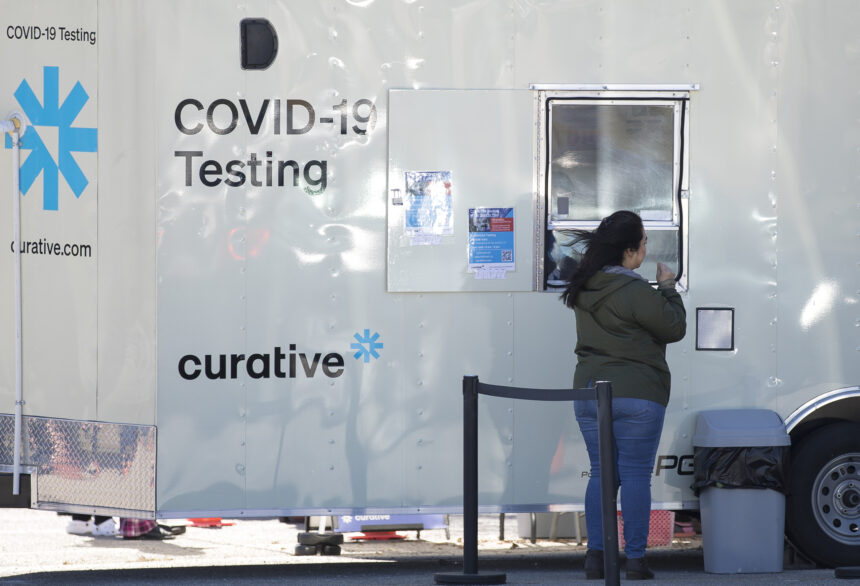Coronavirus cases have been rising in Bexar County in recent weeks, and as Texas rolled back its reportable condition requirement on COVID-19 cases, local officials emphasize it hasn’t gone away.
Though the city has suspended its realtime dashboard showing infection rates and hospitalizations, the Metropolitan Health District said it will still investigate any reported clusters or outbreaks of respiratory illnesses in hospitals or nursing homes.
Here’s what you need to know.
There’s less data about COVID-19 cases
The Texas Department of State Health Services in March mandated that COVID-19 is no longer a Texas Notifiable Condition, taking away the requirement for providers to report positive COVID-19 cases to local and regional health departments across the state.
In San Antonio, that means providers and hospitals aren’t required to report COVID-19 cases to the city’s Metropolitan Health District, and the health department also will no longer report the weekly COVID-19 changes in the community.
Miguel Cervantes, public health administrator for communicable disease for Metro Health, said schools and nursing homes are still required to report unusual increases of COVID-19 cases — for example, if a number of students are absent or if more nursing home residents get sick at the same time.
“If the classroom has 10 kids and 5 or 6 of them are sick, that would be considered a cluster,” he said, adding that those must be reported to Metro Health.
University Health said it will still track all COVID-19 cases at its clinics, emergency rooms and urgent cares in Bexar County at its in-house virology lab.
Infectious disease doctor and University Health epidemiologist Dr. Jason Bowling said COVID-19 cases have been rising the past four weeks in Bexar County.
COVID isn’t going away in San Antonio
During the week of July 1, University Health counted 163 confirmed COVID-19 cases, up from 108 cases the week of June 24.
“It’s really moving up quickly. To put that into context, these are only cases of people that are presenting with symptoms and getting a test that confirms it,” Bowling said.
“It probably means there are a lot more cases in the community for people that are not presenting to health care for a diagnosis,” he said.
Like flu cases, Bowling said the change essentially moved COVID-19 to be included with other respiratory infections, like influenza, rhinovirus and RSV, he said.
“We do have to learn to live with COVID-19 as things move along, but people should not think that it’s gone away,” Bowling said.
Some people are still at high risk for infections, and vaccines are still recommended.
There are new COVID variants
The latest COVID infections are being driven by the KP.3 and KP.2 variants, known as “FLiRT variants” for their mutations, Bowling said. The variants are contagious in public spaces, Cervantes added.
Bowling and Cervantes said there are not any reported new symptoms or more severe infections with these variants, but there has been a spike in cases, most likely because immunity for new variants hasn’t been fully developed in people’s bodies.
If you think you are sick, take precautions.
“If somebody has symptoms right now consistent with COVID, they very well may have COVID. It’s the top respiratory virus we’re seeing circulating in people getting tested,” Bowling said.
Updated vaccine timeline
You should get vaccinated, mask up if you’re sick and go into public areas, and stay home if you’re sick, especially if you’re at risk for severe infection, Bowling said.
Those still at risk for severe infections include anyone who has been hospitalized for COVID-19 and people with underlying health conditions.
An updated COVID-19 vaccine that protects against the new variant will be available in the fall, Bowling said.
“People should get this new vaccine when it becomes available, obviously the problem is that we’re seeing the cases go up now, so people should try to protect themselves,” he said.
At-home tests are still effective in accurately diagnosing COVID-19, he said, and anyone six months and older can be vaccinated against COVID-19.
“You never know the severity of the illness you’ll have. Everyone is different. It’s best to take precautions, especially if yourself or someone in your family is at risk of developing those complications,” Cervantes said.
COVID vaccines are still available at no cost through the federal Bridge Access Program at Metro Health’s pop-up vaccine clinics in San Antonio. To see a list of recent pop-up vaccine clinics, click here.
The Bridge Access Program, which provides free vaccines for uninsured or underinsured adults, will end in August, around the time the new COVID vaccine is expected, Cervantes said.
“Until then, we are able to provide COVID vaccines at no charge to individuals who meet those requirements,” he said. “As of right now, we’re still waiting for additional guidance from the CDC to figure out how we’re going to make this vaccine available.”
Children can still get the updated vaccine free through the Vaccines for Children’s Program.

Long COVID is still a risk
Inside UT Health San Antonio’s Long COVID clinic, three active treatment trials are ongoing and open to anyone who wants to participate. The clinic offers therapies to treat people with long COVID-19 conditions.
So far, researchers have found that reinfection with new variants puts patients at risk of getting long COVID-19, an infection-associated chronic condition, said Dr. Monica Verduzco-Gutierrez, professor and chair of the Department of Physical Medicine and Rehabilitation at UT Health San Antonio.
Despite a lot of questions, what researchers know for sure is that there is something wrong with the body in long COVID cases — whether it’s inflammation, a problem with the immune system or getting an immune condition. But what researchers still don’t have is a blood test to confirm a long COVID diagnosis, she said.
Anyone is at risk of getting long COVID, including people who have preexisting diseases. The most common patient is middle-aged women, Verduzco-Gutierrez said. Additionally, anyone who has had long COVID is at risk for developing a chronic disease like diabetes, she said.
“We know some people who had COVID from the first variant and they’re still dealing with it, and it’s been four years at this point,” she said. “There’s a lot of patients who don’t just get better and don’t just get over it, so that’s why it’s still important to keep COVID infections serious, really try to prevent it, be cautious, mask, and get treated.”
Update: This story has been updated with additional information from University Health.













